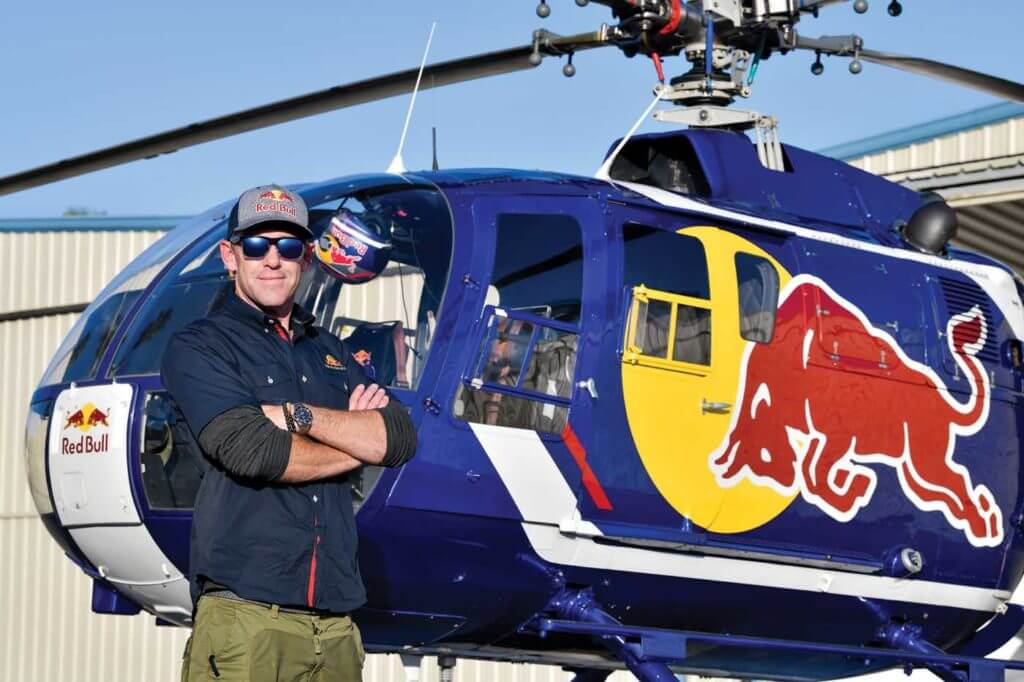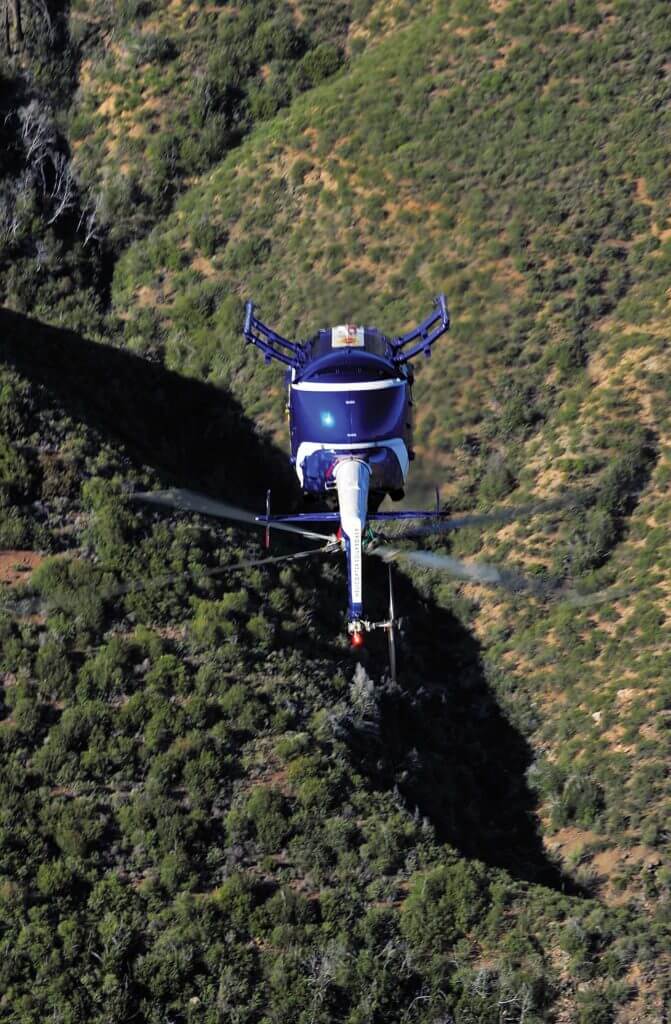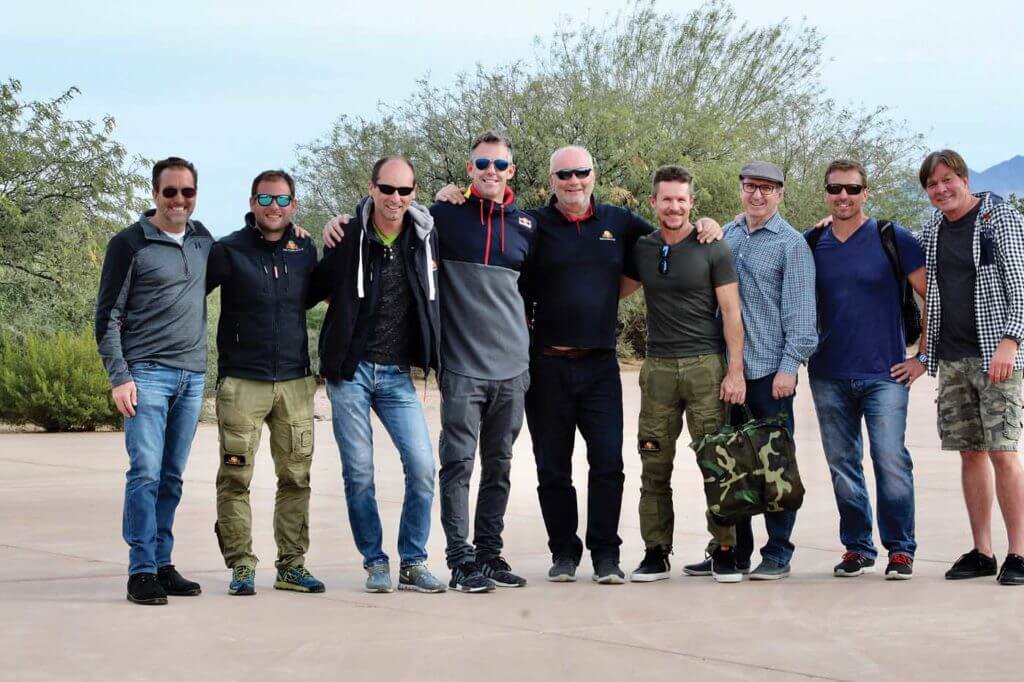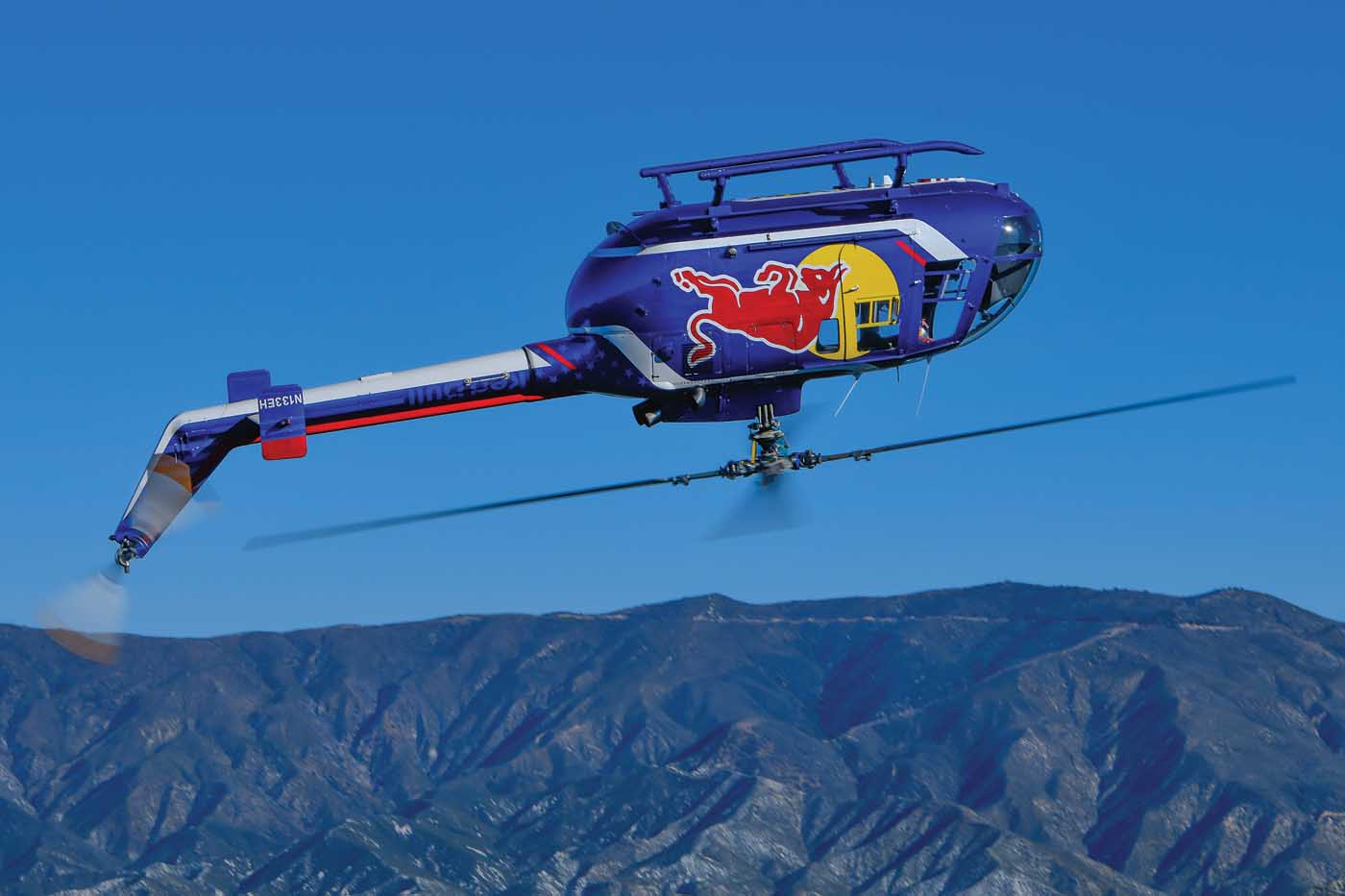The first thing you learn, when you’re learning to fly a helicopter, is just how little you need to move the controls. The control inputs required to maintain a hover are so slight as to barely be perceptible, and if you’re moving the cyclic more than a few inches in forward flight, you’re probably scaring yourself and everyone else on board. From the moment they pick up this delicate control touch, helicopter pilots spend their entire careers cultivating it. It’s comparable to getting very good at balancing one basketball on top of another — if the penalty for dropping a ball were potentially death.
All of which is to say that aerobatics do not come naturally to helicopter pilots (or to helicopters). That was true for Siegfried “Blacky” Schwarz, an Austrian who is currently the chief helicopter pilot of The Flying Bulls and a two-time Helicopter Freestyle World Champion. By the time he started learning aerobatics, Schwarz had spent decades flying helicopters, doing everything from building ski lifts to performing mountain rescues. Learning how to loop and roll was a different experience entirely.
“If you are a pilot and doing sling load work, you only make the movements on the cyclic a millimeter; just very slight movements and gentle,” he said. But some aerobatic moves require full displacement of the cyclic — a control input that, in the beginning, went against every fiber of his being. “It was really terrible!” he laughed. “That was really one of the hardest things. And the other thing is to know your position in the sky. . . . This took some time.”

Airplane aerobatic pilots are a dime a dozen, but helicopter aerobatic pilots are still few and far between. Starting up a safe, successful helicopter aerobatics program demands not only skillful pilots and capable aircraft, but also intensive training, attentive maintenance, and close cooperation with the regulator. Sustaining one requires an enormous commitment of time and resources, meaning that few commercial organizations have both the wherewithal and the appetite for it. Red Bull, the founder of The Flying Bulls, is the exception to the rule.
From their headquarters in Austria, the aerobatic helicopter pilots of The Flying Bulls have been performing continuously in Europe and other parts of the world for more than a decade. However, the North American branch of the program had a quiet few years following the departure of its first U.S. pilot, Chuck Aaron, in 2015.
Now, the program is back with a new pilot, Aaron Fitzgerald, and a renewed commitment to inspiring audiences across North America through inverted vertical flight. In May, Fitzgerald surprised bystanders in New York City with a demo over the Hudson River; in July, he’ll be making his second appearance on aviation’s largest stage, EAA AirVenture Oshkosh in Wisconsin. In advance of this summer’s air show season, we paid a visit to Red Bull’s hangar in Southern California to learn more about the organization’s helicopter aerobatics, and the pioneers who made it all possible.

Expanding the envelope
The first documented loop in a helicopter was flown by Sikorsky test pilot Harold E. “Tommy” Thompson in 1949. The aircraft was an S-52, with three all-metal main rotor blades and a Franklin six-cylinder piston engine. Although it’s possible that other loops predated Thompson’s, no conclusive evidence of them has surfaced, whereas Thompson’s loops can be readily viewed on YouTube.
Since then, helicopter aerobatics have primarily been the domain of people who have had a good reason to do them, notably civil or military test pilots seeking to explore or illustrate an aircraft’s flight envelope. One of those pilots is Rich Lee, who after serving as a U.S. Army scout pilot in Vietnam eventually wound up at Hughes Helicopters, the manufacturer of his OH-6 Cayuse. There, first as a production and then as an experimental test pilot, he learned how to perform maneuvers that crossed the line into aerobatics.
A defining moment for Lee came in 1981, when he was asked to demonstrate a TOW missile-equipped version of the Hughes 500 at the Paris Air Show. Before the show, Lee provided a VIP demo to Bob Hoover, the Second World War fighter pilot and colleague of Chuck Yeager who had gone on to become perhaps the greatest air show pilot of all time.

“During the demonstration, Bob asked me what I intended to do during the show, and I told him, and he said, ‘Well let’s see what you’re doing,'” Lee recalled. “So I did a demonstration with him, and as a result of that he made several safety recommendations that I hadn’t considered.”
Lee modified his plans accordingly, and his display was a success. From that point forward, Lee said, “Bob Hoover became a lifetime mentor, as he did for Sean D. Tucker as well. We could pretty much call on him and ask his advice for everything.”
For Lee’s employer, the purpose of aerobatics was obvious: it was a way to sell more helicopters. And Hughes (later McDonnell Douglas, then Boeing) was not alone in this. “We would compete for contracts, and part of those competitions involved demonstration flights,” Lee explained. “The goal of manufacturers is to present their aircraft in the best possible light, and if you could maneuver in ways the other helicopters couldn’t, that was seen as competitive one-upmanship. So we all got pretty good at flying demonstrations to potential customers,” he said of his fellow test pilots.
During his time with Hughes and its successors, Lee flew aerobatics in the Hughes 300, all models of the Hughes/MD 500, the MD 900, and Boeing AH-64D/E Longbow Apaches at mission gross weight. Although he has never been a civilian entertainer, he has performed at nearly every major air show in the world.

“I can’t say I’m the most experienced helicopter air show pilot in the world, but I would say I’m right up there with the best,” Lee said. “And that just comes with longevity, and exposure to numerous types of aircraft and various types of situations.”
Master of the Bölkow
While Lee was busy looping Apaches, across the Atlantic another legend was emerging. Rainer Wilke became a pilot for the German Army Aviation Corps in 1972. The following year, he was assigned to fly the German Army’s very first Messerschmitt-Bölkow-Blohm (MBB) Bo.105s, which were being trialed as anti-tank helicopters.
By the time deliveries of a specialized anti-tank version commenced in the late 1970s and early 1980s, Wilke was one of the German Army’s most experienced Bo.105 pilots and instructors. If Lee was a generalist, flying many different types of helicopters, Wilke was a specialist — starting early on one model and learning it better than anyone else in the world.

The Bo.105 wasn’t just any helicopter, either. The Bölkow design was pioneering at the time for its rigid rotor system, titanium main rotor head, and fiberglass blades, which gave the aircraft exceptional maneuverability. The German Army realized its aerobatic potential, and assigned one pilot to perform displays in the aircraft. In 1984, with that pilot on the eve of retirement, Wilke was selected as his replacement. During their handover training, however, Wilke found that his predecessor wasn’t particularly eager to pass along his knowledge.
“I was only allowed to sit on the left side, normally the pilot is sitting on the right side . . . and I was allowed to feel the controls for one loop and one roll, that was all,” Wilke recalled.
“When I came back to my squadron, the commander asked me how was the training, was everything fine? I told him about the situation and then he asked me [if I felt] safe enough to do my own training for myself. I said OK, that’s fine, I would do it — and so I started training on my own.”
In 1988, the German military suspended aerobatic flying following the Ramstein air show disaster, in which three Italian Aermacchi MB-339s collided during a flying display. Not long afterward, however, the MBB successor Eurocopter (now Airbus Helicopters) asked Wilke to provide aerobatic training to some of its test pilots. In the years that followed, Wilke worked regularly with the manufacturer as an instructor and display pilot.

At one point, Airbus recommended Wilke to provide instruction in aerobatics to some Chinese students at the Test Flying Academy of South Africa. He wrote an article about his experience for an aviation magazine, and in early 2005, that article came to the attention of Blacky Schwarz.
Among his many other pursuits, Schwarz had started a flight school in Graz, Austria, through which he met Red Bull co-founder and passionate aviation enthusiast Dietrich Mateschitz. Schwarz taught Mateschitz how to fly helicopters on an Airbus EC120, then helped him acquire The Flying Bulls’ first two rotorcraft, a Bell 47 and an Airbus AS355 N. Eventually, Schwarz went to work for The Flying Bulls full-time.
It just so happened that around the time he learned of Wilke, Red Bull North America, which is headquartered in Los Angeles, expressed an interest in developing its own aviation presence. Schwarz thought an aerobatic helicopter program might be a perfect fit, so he gave Wilke a call. Two weeks later they were in L.A., talking late into the night as they laid the groundwork for the new venture.

Getting past the gatekeepers
When Rich Lee and his fellow test pilots at Hughes started flying helicopter aerobatic displays in the ’80s, the Federal Aviation Administration (FAA) wasn’t really sure what to make of them. Unlike airplanes, no helicopters had ever been certified in the acrobatic category, and while aerobatic maneuvers weren’t specifically prohibited in the 500, the FAA’s representatives were generally wary of them. As Lee recalled, “They were a little concerned that here was an activity that they hadn’t thought about very much.”
Lee ended up working with the FAA to write definitions of aerobatic flight for helicopters, which were initially based on pitch and bank angles. (Today, aerobatic flight is defined simply as an intentional maneuver involving an abnormal attitude or acceleration not necessary for normal flight.) Initially, the FAA also reserved the right to issue statements of aerobatic competency to helicopter pilots, although now that privilege rests with the International Council of Air Shows (ICAS), as it does for fixed-wing pilots.
Lacking in-house expertise on the subject, the FAA relied on Lee and similarly qualified individuals to evaluate helicopter pilots for aerobatic competency. Lee said that during the 1990s and early 2000s, he saw applicants perhaps three or four times a year.

“[First] I would start asking questions: well, who trained you, what aircraft are you going to use, what’s the purpose you’re doing this?” he recalled. “And most of the time, that would be the end of the conversation because most of these people didn’t understand how expensive it was going to be, what a commitment it was, what kind of equipment they needed. They just had no concept — they just saw someone do aerobatics in an air show and figured that would be a fun thing that they would like to do.”
For those handful of applicants who weren’t deterred, the next step was to present the aircraft they intended to use. In the U.S., performing aerobatics in a helicopter generally requires a special airworthiness certificate, which is issued with a limitations letter that clearly states what the aircraft can and can’t do. Once a helicopter is used for aerobatics, restoring it to a standard airworthiness certificate is prohibitively expensive — “so expensive that you would be better off selling the helicopter for scrap,” Lee said.
Very few applicants bothered to obtain this special airworthiness certificate. But of those who did, almost all of them washed out during the flight evaluation, “because they hadn’t been taught by anybody and they couldn’t do a routine with consistency, or they couldn’t do what they said they were going to do,” Lee explained. “So the number of pilots who were doing helicopters at air shows was very, very small.”

Then along came Red Bull. Schwarz had gotten the green light from Mateschitz and acquired four Bo.105 helicopters: two for the U.S., which were certificated for aerobatics in the experimental category, and two for Europe, which were eventually certificated in the normal category following extensive negotiations with Airbus. Wilke signed on to the program and provided initial aerobatic training to Schwarz and to Chuck Aaron, who had developed a relationship with The Flying Bulls when he sold them their AH-1F Cobra. With that backing and training behind him, Aaron was granted his statement of aerobatic competency, and began performing aerobatic displays in 2006.
“Red Bull does an excellent job,” said Lee. “They’re well funded, they’ve retained the very best instructors, they spare no expense in helicopter safety or pilot safety. . . . They have the money and, more importantly, the dedication to safety that’s necessary to demonstrate at air shows.”
Striving for perfection
If there are tricks to flying aerobatics in a helicopter, one of them is knowing where to look. Aaron Fitzgerald explains this to me before taking me up in a demo in one of Red Bull’s U.S.-registered Bo.105s. For example, he says, when you’re moving backwards through a loop, you should be tilting your head back, not looking straight out through the windscreen. I liken the advice to looking through the turn while taking a curve on a motorcycle, and it seems to work — both for staying oriented and avoiding airsickness.

Fitzgerald grew up fascinated by helicopters in Wenatchee, Washington, which at the time was home to an active helicopter logging industry (and source of the term “Wenatchee snatch,” a maneuver that logging pilots used to carry more weight than was good for them). After serving as a paratrooper in the U.S. Army’s 82nd Airborne Division, Fitzgerald did his helicopter flight training in L.A., then started working in news helicopters both as a pilot and a camera operator. Although he did a variety of flying jobs over the years — including building power lines with MD 500s — film and television support remained a focus for him, and he eventually started his own aerial production company, Airborne Images.
Fitzgerald began working with Red Bull about 12 years ago, when he dropped the company’s skydiving team, the Red Bull Air Force, into a NASCAR race.
“That gave way to a whole bunch of filming jobs over the years, and I’ve worked very closely with them on very big projects,” he explained. When the aerobatic position came open, Schwarz asked Fitzgerald if he’d like to give it a try. His answer was, “Of course.”
For Fitzgerald, the process of learning from Wilke and Schwarz how to fly aerobatics was “enlightening.” Much as Schwarz had, he struggled with the process of unlearning 20 years of muscle memory devoted to keeping helicopters upright.

“Mentally, you understand how the maneuver is done, and it’s easy to enter it; your hands and feet do what you want,” he said. “But then once you’re in the maneuver and you’re inverted or you’re in a strange attitude, your hands and feet do everything they can to get you back right side up, and that’s instinctive. So for me, it was learning counterintuitive control inputs in order to continue around in a roll instead of immediately trying to right it.”
After he broke those instincts, the bigger challenge came from learning how to combine individual maneuvers — loops and barrel rolls and Immelmans and backflips and half Cuban eights — into a smoothly flowing routine. As he explained, “It’s not so challenging to go learn how to do a loop, you can do that over and over again and get it just right. What’s really challenging is to get ahead of yourself a couple of maneuvers, so as you’re recovering from one maneuver you’re setting up for the entry into the other one, and all the while managing the show line, and the altitude, and the airspeed.”
Of course, that challenge is also a large part of the appeal of aerobatic flying. No matter how successful a routine, it’s always possible to make it better: smoother, faster, more precise. Said Fitzgerald: “I don’t know that it’s possible to fly a perfect aerobatic sequence, so the fun for me is in the challenge of trying to make it more perfect every time.”
The importance of mentorship
The 1981 Paris Air Show wasn’t the only time that Bob Hoover saved Rich Lee’s performance, and possibly his life. Lee recalled a private air show for the secret club of airline executives called “Conquistadores del Cielo,” which took place in Ruidoso, New Mexico, at an elevation of around 7,000 feet. Hoover was there in a North American P-51 Mustang, while Lee was flying an MD 500.

Instead of bowing out, or, more perilously, persisting with his original plan, Lee went to Hoover for advice. “Bob and I talked over what we were doing, the aerodynamic reasons that I was having problems, and how we could structure the show to do maneuvers in a way that would be safe, yet still somewhat exciting,” Lee said.
“There have been people who stepped in at various points in my career and given me important insights. But if I have to say why I’m alive and talking to you right now, and why I’ve had a successful air show or demonstration career, it’s directly the result of Bob Hoover’s mentorship.”
For Lee and Wilke, the time has come to pay it forward — sharing their decades of accumulated wisdom with a new generation of helicopter aerobatic pilots. Although Lee is still an aerobatic competency evaluator, he has been handing over the reins to Scott Urschel of Pylon Aviation, who now performs evaluations for the Red Bull program on behalf of ICAS. Likewise, Wilke has been spending less time on the air show circuit recently, ceding the spotlight to younger pilots like Fitzgerald and the Italian Red Bull pilot Mirko Flaim. Next in line is the Austrian Felix Baumgartner, who gained fame for skydiving from the stratosphere for the Red Bull Stratos project, and recently gained his own statement of aerobatic competency in helicopters.

“I see my main thing at the moment to train the other pilots — to give all my experience, what I have learned, to them, so that they are able to continue and do all the same like I did in the past,” Wilke said. There are still a few maneuvers that no one besides Wilke is performing, and unlike the pilot who gave him his initial “training,” Wilke is eager to pass them along.
As far as Lee is concerned, aerobatic maneuvers in a civil helicopter have no useful purpose beyond an aerobatic display. And the motivation for such displays is often to sell something, be it aircraft or energy drinks. Nevertheless, programs like Red Bull’s also serve to raise the profile of the helicopter industry with people who might otherwise ignore it.
“In most types of helicopter flying, we work really hard out in the middle of nowhere, doing some tremendous flying, and no one sees it,” Fitzgerald pointed out. For him, the real privilege of his work with Red Bull is not in being able to fly a helicopter upside down, but in sharing his passion with tens of thousands of spectators.
“When I’m in front of a crowd at an air show, I’m representing all of the helicopter industry, because there’s not too many helicopter performers out there,” he said. “It’s a great honor to be able to represent our little sector of the aviation world in front of the greater air show audience.”






Awesome Article, Elan!
I would love to experience the BO105 again, but this upside down! 🙂
Keep up the good work.
God Bless, jess
I like Lee’s quote about making sure that they could do exciting yet safe stunts for the airshow. I imagine safety is a big concern for these types of maneuvers. If I ever needed a helicopter ride or pilot, I’d want to find someone that valued that as much as Rich Lee!